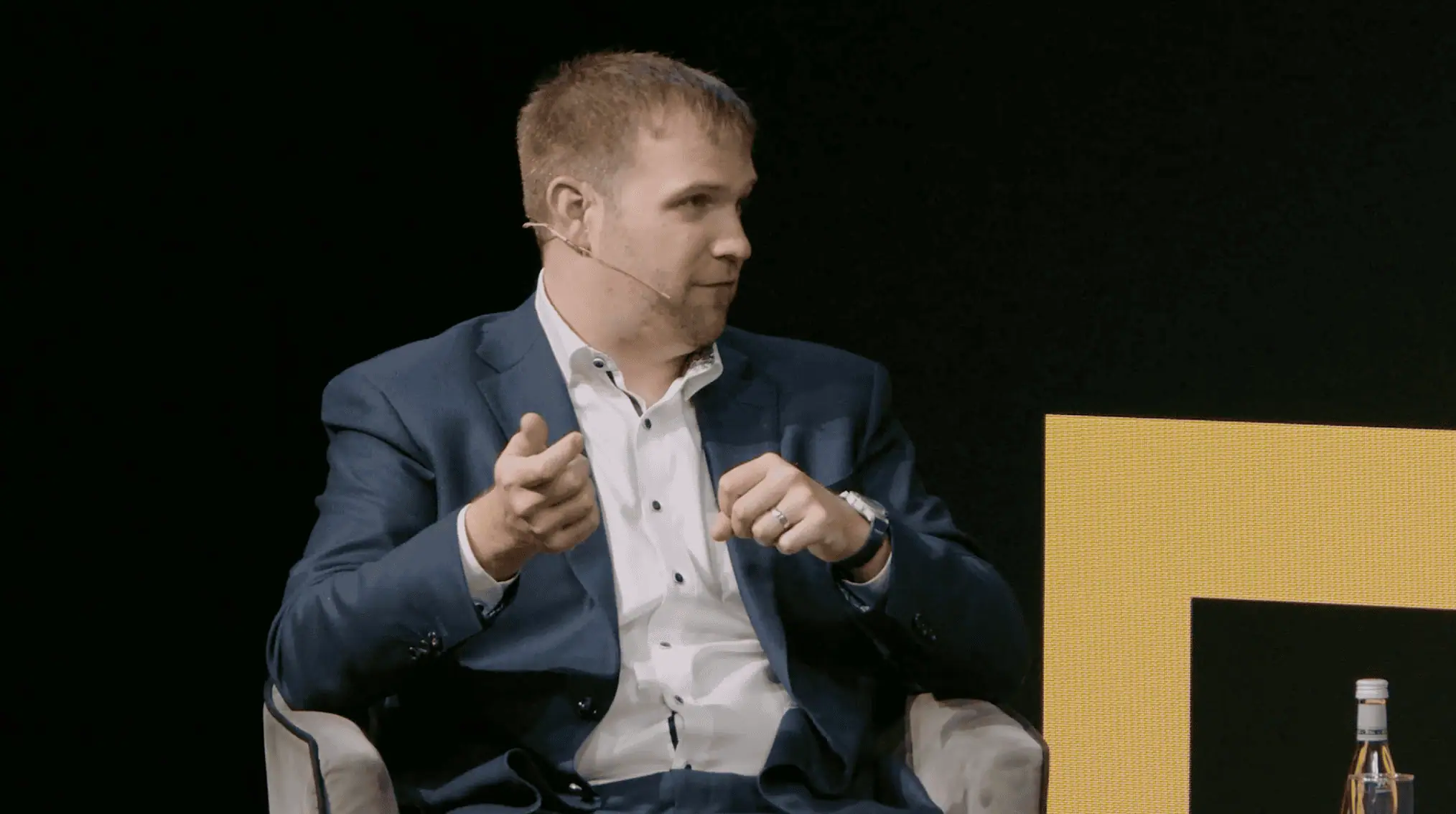|
Getting your Trinity Audio player ready...
|
At the London Blockchain Conference 2024, one panel focused on the occasionally thorny issue of stablecoins, particularly those issued by private firms, and their role in on-chain digital payment solutions.
The panel was moderated by Sebastian Ploetzeneder, Senior Strategy Manager and Public Affairs Director U.K. for enterprise blockchain technology firm nChain. Ploetzeneder’s guests included Reginald Tumusiime, President of the Blockchain Association of Uganda; Bernhard Müller, General Manager/Chairman at Zurich-based digital payments operator Centi Ltd; and Harbind Likhari, VP of Trading And Exchange Services with the self-custodial RockWallet.
Ploetzeneder started by quizzing Müller about CCHF, a Swiss franc-based token that became the first native stablecoin on the BSV blockchain in March 2023. Unlike some well-known stablecoins, Müller claimed CCHF was “capable of radical micropayments,” which is not some idle boast. Earlier this year, Centi processed one million one-cent CCHF transactions in a single 24-hour period as a demonstration at the Finovate Europe 2024 conference.

CCHF is also a stablecoin outlier due to Centi’s willingness to do direct-to-consumer sales of the token, rather than requiring users to purchase the token via a digital asset exchange. Centi has partnered with thousands of Swiss merchants to enable the use of CCHF for everyday purchases.
With CCHF fully backed by a Swiss bank guarantee, Müller said Centi was looking to “build consumer trust” in stablecoins, something currently lacking given the refusal by Tether (USDT) to submit to a third-party audit and Circle (USDC) almost losing $3.3 billion following Silicon Valley Bank’s 2023 collapse.
Centi has also promoted its ability to transform remittance services to African countries, prompting Ploetzeneder to ask Tumusiime what African firms are looking for in terms of payments.
Tumusiime, who has a track record with small and medium enterprises (SME) as well as in private equity, noted Africa’s unique history with “mobile money” via major telecom operators such as Safaricom, Airtel, and others. Tumusiime said Safaricom’s MPESA and Airtel Money are “basically privately issued money.”
Tumusiime said it’s important to realize that Africa’s telcos weren’t usurping the role of central bankers. “All they did was have money that is circulating through their networks backed by actual cash in trust accounts in the largest banks in their respective markets. So you’re providing infrastructure to enable payments across the country, but not necessarily creating a new currency.”
Regardless, the central banks of several East African countries are now “having discussions about a monetary union, how do we merge our currencies. There’s nothing better than CBDC’s [central bank digital currencies] to solve this problem.” Tumusiime pointed to an International Monetary Fund (IMF) survey that found 75% of countries in sub-Saharan Africa were “thinking of some form of CBDC.”
Tumusiime said the telcos had identified “a gap in financial inclusion” that was leaving large segments of African populations unbanked. In addition, Tumusiime said lately he’d noticed “a bit of complacence within these telcos,” leading to increased remittance fees and higher thresholds for the minimum amount of money you can send, among other inconveniences.
Tumusiime’s CapitalSavvy is now “leveraging on the success of mobile money to provide a better solution” using blockchain. Tumusiime noted that regulation is usually a bottleneck in most jurisdictions, but African countries’ years of experience with mobile money mean that “there’s no better positioned region to have a fast use case for privately issued money.”
Out, damned fees!
RockWallet’s Likhari said banking was one of the biggest challenges in the digital asset space. Most top-tier banks remain skittish about blockchain-related activities, forcing companies to deal with second-tier banks “where the services generally aren’t as fluid.”
This constrained access to fiat channels also impacts RockWallet’s customers. “Whether they want to go long or short a particular asset, they keep the proceeds in stablecoins at the end of trading. In order to keep investing again and again, they use stablecoins as value transfer between themselves and other entities.” In other words, they’re willing to pay for the convenience or (more appropriately) the lack of inconvenience involved in converting digital assets to fiat and vice versa.
Likhari observed that Ethereum users were once happy to pay high ‘gas’ fees to ensure their transactions were processed swiftly, reasoning that they “would likely pay the same amount wiring funds from one bank to another.” But as the market has evolved, “we’re seeing people wanting to cut down on all fees.”

Likhari cited the “new generation of coins” that offer extremely low transaction fees—like MNEE, the BSV-based stablecoin that RockWallet is integrating that charges 1/10th of a cent fees—as an example of “where value gets unlocked. That’s where you get to keep more of your proceeds. The more you keep, the happier you are.”
Customers are also looking for faster transactions. When RockWallet launched in late 2022, Likhari said, “We’d have to wait for USDC/USDT to be confirmed on-chain before customers could trade the asset. That might be 7-10 minutes but even that duration caused a lot of consumer anxiety. We had to change the way we approach that, telling customers they could deposit and trade immediately, but they’d have to wait to withdraw.”
Likhari noted that blockchains such as BSV allow zero-confirmations, “and that helps,” as do less onerous transfer fees. “When withdrawing funds on an ERC-20 protocol, [fees] could go anywhere from $5 to $15 versus BSV where it’s 1/10 of a cent.”
Ploetzeneder asked Likhari what RockWallet’s consumer focus meant when it came to expanding its product offering. Likhari said, “People and particularly institutions are becoming more and more aware” of their need to understand “what goes behind the stablecoin.”
This includes a stablecoin issuer being upfront with how it accounts for its fiat reserves, what freezing/blacklisting processes they have in case of sanctions, amongst other criteria. “That’s where the retail public will move towards, and they should because no stablecoin should be too big to fail. Transparency should be as good as a public company because people have so much invested in them.”
Only as good as your rails
Ploetzeneder wondered what considerations Centi made when choosing BSV as the blockchain on which it would build its foundation. Müller said Centi was “looking for economies of scale” as a payments company. Unfortunately, 99% of blockchains have reverse economies of scale, which doesn’t really work to grow a business or any sort of enterprise.”
BSV’s capacity for digital asset recovery also helped nudge Centi toward the chain. “It’s not like we could at our discretion just freeze/hold something, for that you need an enforceable court order, which makes sense if you want to claw/claim back some money. This procedure exists on this blockchain for any asset for anyone that is building anything on this blockchain, which is actually pretty good.”
Müller returned to Tumusiime’s comments about unbanked Africans. “The stablecoin is something which can hugely empower the unbanked. We don’t have to go to Africa or Southeast Asia—there are 22.8 million unbanked people here in Europe. When we chose the protocol to put our stablecoin on, a very important factor for us—and for the Swiss regulator—was that there is no discretion over the transactions.”
In Switzerland, Centi users “can trade up to CHF1,000 of cash/ETH/credit card for this stablecoin and against it with each user without going through the KYC process. You can be an undocumented person. We just have to make sure you’re not the same person as another account … It’s a market that no bank, no other financial service provider wants to touch” without full KYC. This is both a huge market opportunity and “a huge opportunity to help people, drive financial inclusion, get those people back into the economy.”
Ploetzeneder wondered about the potential intersection of stablecoins with other offerings to achieve things that were once economically infeasible. Müller sees vast potential in B2B intercompany payments, using his previous work with biotech firm Roche.
“We’d sell an invitro diagnostic machine for $200,000 to Malaysia. The Australian affiliate might make the sale, but big corporation profits are always centralized somewhere that taxes are low. So the money has to legally go through this Aussie affiliate through the Singaporean one then to Switzerland and so on. All these banks make a lot of money on the float and your working capital is somehow tied up for two weeks in this process. If we have trustworthy, usable stablecoins, we can just keep it for a logical second in each place, so the bookkeeper’s happy and you have liquidity available.”

Private money vs. central banks
Ploetzeneder remarked on the irony of ‘crypto’ fans celebrating the possible destabilization of the U.S. dollar while embracing dollar-denominated stablecoins. Tumusiime said for Africans, the situation was “very nationalistic in that we’re focused on our own currency at the moment.”
Some African countries have had a rough time launching CBDCs (think Nigeria’s eNaira), but with regulations like the National Payment System Act in Uganda already in place, Tumusiime’s goal is to show central bankers “how they can leverage blockchain in a permissionless environment.”
Tumusiime said he was “starting to see the same mindsets about privately issued money on Web3—the same concept but leveraging the technology around blockchain and finding the right partners to work with to provide a better, faster, more reliable, secure payment gateway.”
Tumusiime said “such initiatives actually help drive monetary policy through the system, because the more people you have banked, your monetary policy becomes more effective in the market. This has been a very key bottleneck for planning for central banks because a lot of [unbanked] people in Africa keep money in their house. It’s a hassle to move it around, so if we keep innovating it’s a good thing” for everyone.
Keep it simple, stupid
Centi’s Müller reminded the audience that everyone in attendance was blockchain-savvy, but when talking to ‘normal’ people it was important to remember just how alien all this terminology seems to them.
“If we want to bring this technology, the power and the transaction capabilities to the people, we have to give them the medium in which they think, in which they make purchasing/consumer decisions, in which they earn their salary. Because everything else creates irritation, confusion. People don’t want to learn about something first, they want to try it.”
“At Centi, we now have a lot more onboarding methods, but when I look at the app, I think, ‘this would be confusing for my mom.’ So how do I abstract my [user experience] again and make sure everybody only sees what is needed and maybe what they expect.”
Tumusiime agreed, saying, “What drives value is ease. No one really cares about complicated infrastructure, systems, concepts—people need a workable solution.” In Africa, privately issued money thrives because “it was a solution that was available, it worked, and so people didn’t really care whether it was a telco or a bank.”
Looking ahead
Ploetzeneder wrapped things up by asking each of his guests where they saw ‘the future of money’ in 5-10-20 years, whether it would be driven by banks, the private sector, or some hybrid model.
Likhari said CBDCs “have some value but are limited in terms of cross-border payments. That’s where private blockchains come in. You can have a smart contract on top of it to do additional functions, so there will be harmony between both public/private.”

Tumusiime said growth in Africa will continue to be primarily driven by the private sector, as “central banks are very trusted, but the speed with which they move due to red tape will provide the avenue for young entrepreneurs to thrive.”
Müller also saw private sector innovation as the main driver going forward, “but I hope that if central banks come with their CBDCs and they do it right—transparent and easy, creating trust—I think we’ll see certain power shifts based on the monetary aspect. For example, the BRICS states want to create a single CBDC. Regardless of these countries’ popularity, if you bring this and it’s government-backed with transparency, it has huge potential. If their currency is more desirable, it will find adoption.”
Watch Centi: Bridging digital money and traditional banking

 09-11-2025
09-11-2025 





